 W
WThe Macintosh 128K, originally released as the Apple Macintosh, is the original Apple Macintosh personal computer. Its beige case consisted of a 9 in (23 cm) CRT monitor and came with a keyboard and mouse. A handle built into the top of the case made it easier for the computer to be lifted and carried. It had an initial selling price of $2,495. The Macintosh was introduced by the now-famous $370,000 television commercial directed by Ridley Scott, "1984", that aired on CBS during the third quarter of Super Bowl XVIII on January 22, 1984. Sales of the Macintosh were strong from its initial release on January 24, 1984, and reached 70,000 units on May 3, 1984. Upon the release of its successor, the Macintosh 512K, it was rebranded as the Macintosh 128K. The computer is Model M0001.
 W
WThe Macintosh 512K is a personal computer that was designed, manufactured and sold by Apple Computer, inc. from September 1984 to April 1986. It is the first update to the original Macintosh 128K. It was virtually identical to the previous Macintosh, differing primarily in the amount of built-in random-access memory. The increased memory turned the Macintosh into a more business-capable computer and gained the ability to run more software.
 W
WThe Macintosh 512K enhanced (512Ke) was introduced in April 1986 as a cheaper alternative to the top-of-the-line Macintosh Plus, which had debuted three months previously. It is the same as the Macintosh 512K but with the 800K disk drive and 128K of ROM used in the Macintosh Plus. Like its predecessors, it has little room for expansion. Some companies did create memory upgrades that brought the machine up to 2 MB or more. It is the earliest Macintosh model able to run System Software 6. It is also the earliest that can be used as an AppleShare server and, with a bridge Mac, communicate with modern devices.
 W
WThe Macintosh Classic was a personal computer designed, manufactured and sold by Apple Computer, Inc. from October 1990 to September 1992. It was the first Macintosh to sell for less than US$1,000.
 W
WThe Macintosh Classic II is a personal computer designed, manufactured and sold by Apple Computer, Inc. from October 1991 to September 1993. Like the Macintosh SE/30 it replaces, the Classic II was powered by a 16 MHz Motorola 68030 CPU and 40 or 80 MB hard disk, but in contrast to its predecessor, it was limited by a 16-bit data bus and a 10 MB memory ceiling. The slower data bus resulted in the Classic II being 30% slower than the SE/30.
 W
WThe Macintosh Color Classic is a personal computer designed, manufactured and sold by Apple Computer, Inc. from February 1993 to May 1995. It has a "all-in-one PC" design, with a small, integrated 10″ Sony Trinitron display at 512 × 384 pixel resolution.
 W
WThe Macintosh II is a personal computer designed, manufactured and sold by Apple Computer, Inc. from March 1987 to January 1990. It is the first model of the Macintosh II family, and the first Macintosh to support a color display. When first introduced, a basic system with 20 MB drive and monitor cost US$5,498. With a 13-inch color monitor and 8-bit display card the price was around US$7,145. This price placed it in competition with workstations from Silicon Graphics, Sun Microsystems, and Hewlett-Packard.
 W
WThe Macintosh IIci is a personal computer designed, manufactured, and sold by Apple Computer, Inc. from September 1989 to February 1993. It is a more powerful version of the Macintosh IIcx, released earlier that year, and shares the same compact case design. With three expansion slots, the IIci improved upon the IIcx's 16 MHz Motorola 68030 CPU and 68882 FPU, replacing them with 25 MHz versions of these chips.
 W
WThe Macintosh IIcx is a personal computer designed, manufactured and sold by Apple Computer, Inc. from March 1989 to March 1991. Introduced six months after the Macintosh IIx, the IIcx resembles the IIx and provides the same performance, but is seven inches narrower, ten pounds lighter, and quieter due to a smaller internal fan. The relative compactness results in three NuBus slots being available, compared with six on the IIx.
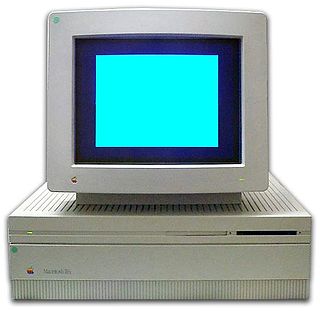 W
WThe Macintosh IIfx is a personal computer designed, manufactured and sold by Apple Computer, Inc. from March 1990 to April 1992. At introduction it cost from US$9,000 to US$12,000, depending on configuration, and it was the fastest Macintosh available at the time.
 W
WThe Macintosh IIsi is a personal computer designed, manufactured and sold by Apple Computer, Inc. from October 1990 to March 1993. Introduced as a lower-cost alternative to the other Macintosh II family of desktop models, it was popular for home use, as it offered more expandability and performance than the Macintosh LC, which was introduced at the same time. Like the LC, it has built-in sound support, as well as support for color displays, with a maximum screen resolution of 640 × 480 in eight-bit color.
 W
WThe Macintosh IIvi is a personal computer designed, manufactured, and sold by Apple Computer, Inc. from September 1992 to February 1993. The IIvi was introduced alongside the Macintosh IIvx, using a slower processor and no floating point unit. The Performa 600 models, meanwhile, are the IIvi with the IIvx's 32 MHz CPU. The IIvi was, on some benchmarks, faster than the IIvx. It is the only model in the Macintosh II family to be branded as a Performa.
 W
WThe Macintosh IIvx is a personal computer designed, manufactured and sold by Apple Computer, Inc. from October 1992 to October 1993. It is the last of the Macintosh II family of Macintosh computers. The IIvx was introduced at the same time as the Macintosh IIvi, Performa 600 and Performa 600CD, with all four models using the same new metal case design. Like the Performa 600CD, the IIvx could be equipped with an internal double-speed CD-ROM drive.
 W
WThe Macintosh IIx is a desktop computer designed, manufactured, and sold by Apple Computer, Inc. from September 1988 to October 1990. This model was introduced as an update to the original Macintosh II, replacing the 16 MHz Motorola 68020 CPU and 68881 FPU with a 68030 CPU and 68882 FPU running at the same clock speed. The initial price of the IIx was US$7,769 or US$9,369 for the version with a 40 MB hard drive.
 W
WThe Macintosh LC is a family of personal computers designed, manufactured and sold by Apple Computer, Inc. from 1990 to 1997.
 W
WThe Macintosh LC is a personal computer designed, manufactured, and sold by Apple Computer, Inc. from October 1990 to March 1992.
 W
WThe Macintosh LC II is a personal computer designed, manufactured, and sold by Apple Computer, Inc. from March 1992 to March 1993. The LC II is an update to the original Macintosh LC, replacing its Motorola 68020 processor with a 68030 and increasing the onboard memory to 4 MB. The LC II was priced at US$1,699, fully $800 less than the original LC when it was introduced.
 W
WThe Macintosh LC III is a personal computer designed, manufactured, and sold by Apple Computer, Inc. from February 1993 to February 1994. It replaced the commercially successful Macintosh LC II in Apple's lineup of mid-range computers, and was significantly faster, with MacWorld Magazine benchmarks showing 2x performance in all major categories - CPU, disk, video and maths. It was also significantly less expensive; the LC III with an 80 MB hard disk was priced at US$1,349 at introduction, $700 less than the LC II. The LC III was sold primarily to educational institutions, and a corresponding Performa variant called the Performa 450 was sold to the consumer market.
 W
WThe Macintosh Plus computer is the third model in the Macintosh line, introduced on January 16, 1986, two years after the original Macintosh and a little more than a year after the Macintosh 512K, with a price tag of US$2599. As an evolutionary improvement over the 512K, it shipped with 1 MB of RAM standard, expandable to 4 MB, and an external SCSI peripheral bus, among smaller improvements. Originally, the computer's case was the same beige color as the original Macintosh, Pantone 453, however in 1987, the case color was changed to the long-lived, warm gray "Platinum" color. It is the earliest Macintosh model able to run System 7.
 W
WMacintosh Portable is a portable computer designed, manufactured, and sold by Apple Computer, Inc. from September 1989 to October 1991. It is the first battery-powered Macintosh, which garnered significant excitement from critics, but sales to customers were quite low. It featured a fast, sharp, and expensive black-and-white active matrix LCD screen in a hinged design that covered the keyboard when the machine was not in use. The Portable was one of the early consumer laptops to employ an active matrix panel, and only the most expensive of the initial PowerBook line, the PowerBook 170, used one, due to the high cost. The machine was designed to deliver high performance, at the cost of increased price and weight. The Portable was discontinued in October 1991.
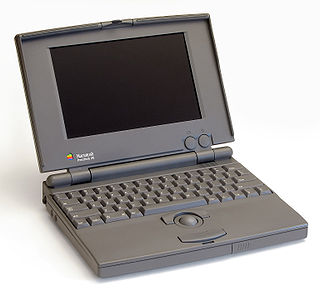 W
WThe PowerBook 100 is a portable subnotebook personal computer designed and manufactured by Sony for Apple Computer and introduced on October 21, 1991, at the COMDEX computer expo in Las Vegas, Nevada. Priced at US$2,300, the PowerBook 100 was the low-end model of the first three simultaneously released PowerBooks. Its CPU and overall speed closely resembled those of its predecessor, the Macintosh Portable. It had a Motorola 68000 16-megahertz (MHz) processor, 2-8 megabytes (MB) of memory, a 9-inch (23 cm) monochrome backlit liquid crystal display (LCD) with 640 × 400 pixel resolution, and the System 7.0.1 operating system. It did not have a built-in floppy disk drive and was noted for its unique compact design that placed a trackball pointing device in front of the keyboard for ease of use.
 W
WThe PowerBook 140 was released in the first line of PowerBooks. It was the mid-range PowerBook, between the low-end 100 and the high-end 170. As with the PowerBook 170, and unlike the 100, this PowerBook featured an internal floppy drive. Codenames for this model are: Tim Lite, Tim LC, Replacements, and Leary. In 1992, it was replaced by the PowerBook 145, which was essentially a speed bump, though the PowerBook 160 essentially superseded it as the new mid-line model.
 W
WThe PowerBook 150 is a laptop personal computer created by Apple Computer, Inc. which was introduced on July 13, 1994, and released on July 18, 1994. It was the last member of the PowerBook 100 series to use the original case design, the most affordable of the series when introduced and also the last consumer model.
 W
WThe PowerBook 160 is a portable computer that was released by Apple Computer along with the PowerBook 145 and PowerBook 180 in October 1992. At the time, it constituted the mid-range model replacing the previous PowerBook 140 in processing power. The PowerBook 160 was sold until May 1994.
 W
WThe PowerBook 170 was released by Apple Inc. in 1991 along with the PowerBook 100 and the PowerBook 140. Identical in form factor to the 140, it was the high end of the original PowerBook line featuring a faster 25 MHz Motorola 68030 processor with Floating point unit (FPU) and a more expensive and significantly better quality 10 in (250 mm) active matrix display. It was replaced by the PowerBook 180 in 1992.
 W
WThe PowerBook 180 is a portable computer released by Apple Computer, Inc. along with the PowerBook 160 in October 1992. At the time, it constituted the new top-of-the-range model, replacing the previous PowerBook 170. Its case design and features are the same as that of the 170, but it shipped with the more powerful 33 MHz Motorola 68030 CPU and Motorola 68882 FPU. Along with the 160, it introduced a new power-saving feature which allowed the processor to run at a slower 16 MHz rate, the same speed as the original 140.
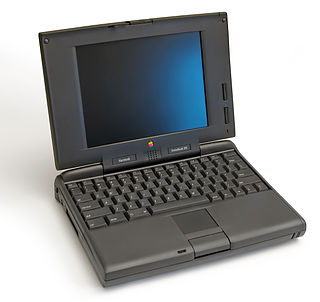 W
WThe PowerBook 190 and its companion PowerBook 190cs are laptop computers manufactured by Apple Computer as part of their PowerBook brand, introduced to the market in August 1995. The two models differ only in their screen: The 190 had a 9.5" greyscale display, while the 190cs featured a 10.4" color display. Apple's target sales audience for this model was the college student in need of a no-frills portable computer. In terms of hardware, along with the PowerBook 150, the 190 has much in common with Apple's "professional" laptop of the same period, the PowerBook 5300 series. In exchange for the cheaper price point, the 190 was equipped with a passive matrix LCD rather than a crisper active matrix screen. More significantly, while the 5300s ran PowerPC 603e processors at 100 or 117 MHz, the 190 had only a Motorola 68LC040 clocked at 33 MHz - in fact, the 190s were the last Macintoshes to use a 68k CPU. However, Apple offered a PPC upgrade for the 190, a heavily marketed selling point for all new 68040 Macs at the time. In addition, a rather cramped 500 MB IDE hard drive was standard, and factory models shipped with System 7.5.2. It is the only one of the 100 series PowerBooks that does not use the original 140 case design, thus was the only one to include a 68040 processor, a trackpad rather than the standard trackball, and along with the 150 the only ones to provide for more than 14MB RAM expansion and larger, less-expensive IDE drives. The 190 was the de facto replacement for the PowerBook 500 series, which was completely discontinued with the introduction of the 5300 and the only 68040-based PowerBook Apple offered.
 W
WThe PowerBook 500 series is a range of Apple Macintosh PowerBook portable computers first introduced by Apple Computer with the 540c model on May 16, 1994. It was the first to have stereo speakers, a trackpad, and Ethernet networking built-in.
 W
WThe PowerBook Duo is a line of subnotebooks manufactured and sold by Apple Computer from 1992 until 1997 as a more compact companion to the PowerBook line. Improving upon the PowerBook 100's portability, the Duo came in seven different models. They were the Duo 210, 230, 250, 270c, 280, 280c, and 2300c, with the 210 and 230 being the earliest, and the 2300c being the final incarnation before the entire line was dropped in early 1997.
 W
WThe Macintosh Quadra 605 is a personal computer designed, manufactured, and sold by Apple Computer, Inc. from October 1993 to July 1996. The model names reflect a decision made at Apple in 1993 to follow an emerging industry trend of naming product families for their target customers – Quadra for business, LC for education, and Performa for home. Accordingly, the Performa 475 and 476 was sold in department stores and electronics stores such as Circuit City, whereas the Quadra was purchased through an authorized Apple reseller.
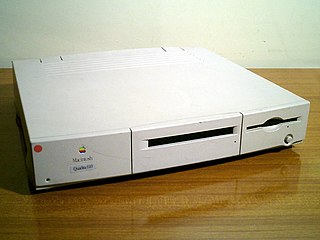 W
WThe Macintosh Quadra 610, originally called the Macintosh Centris 610, is a personal computer designed, manufactured and sold by Apple Computer from February 1993 to July 1994. The Centris 610 was introduced alongside the larger Centris 650 as the replacement for the Macintosh IIsi, and it was intended as the start of the new midrange Centris line of computers. Later in 1993, Apple decided to follow an emerging industry trend of naming product families for their target customers – Quadra for business, LC for education, and Performa for home – and folded the Centris 610 into the Quadra family.
 W
WThe Macintosh Quadra 630 is a personal computer designed, manufactured and sold by Apple Computer, Inc. from July 1994 to October 1995. It was introduced as the replacement for the Quadra 610, and was the least-expensive computer in the Macintosh lineup with prices starting at $1,199 USD.
 W
WThe Macintosh Quadra 650, originally called the Macintosh Centris 650, is a personal computer designed, manufactured and sold by Apple Computer from February 1993 to September 1994. The Centris 650 was introduced alongside the smaller Centris 610 as the replacement for the Macintosh IIci, IIvi and Quadra 700, and it was intended as the start of the new midrange Centris line of computers. Later in 1993, Apple decided to follow an emerging industry trend of naming product families for their target customers – Quadra for business, LC for education, and Performa for home – and folded the Centris 650 into the Quadra family.
 W
WThe Macintosh Quadra 660AV is a personal computer designed, manufactured and sold by Apple Computer Inc. from July 1993 to September 1994. It was introduced alongside the Quadra 840AV; the "AV" after both model numbers signifies video input and output capabilities and enhanced audio.
 W
WThe Macintosh Quadra 700 was a personal computer designed, manufactured and sold by Apple Computer, Inc. from October 1991 to March 1993. It was introduced alongside the Quadra 900 as the first computers in the Quadra series using Motorola 68040 processor. It is also the first computer from Apple to be housed in a mini-tower form factor, which in 1991 was becoming a popular alternative to standard desktop-on-monitor cases that were common through the 1980s.
 W
WThe Macintosh Quadra 800 is a personal computer that is a part of Apple Computer's Quadra series of Macintosh computers.
 W
WThe Macintosh Quadra 840AV is a personal computer designed, manufactured and sold by Apple Computer, Inc. from July 1993 to July 1994. It was introduced alongside the Centris 660AV, the "AV" after both model numbers signifying video input and output capabilities, as well as enhanced audio. The 840AV has the same mini tower form factor as the Quadra 800, with a faster Motorola 68040 processor.
 W
WThe Macintosh Quadra 900 is a personal computer designed, manufactured, and sold by Apple Computer, Inc. from October 1991 to May 1992. It was introduced alongside the Quadra 700 as the first computers in the Quadra family of Macintosh computers using the Motorola 68040 processor. It is also the first computer from Apple to be housed in an 18.6 inch tall mid-tower form factor, which by 1991 had gained momentum with PC manufacturers as a suitable design for departmental servers.
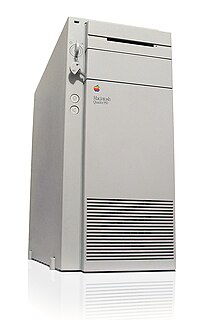 W
WThe Macintosh Quadra 950 is a personal computer designed, manufactured and sold by Apple Computer, Inc. from March 1992 to October 1995. It replaced the Quadra 900 that was introduced several months earlier, increasing the CPU clock rate of its 68040 CPU from 25 MHz to 33 MHz, and improving the graphics support. The two computers were otherwise identical, including the price. With a Macintosh Processor Upgrade Card installed, this computer is known as the Power Macintosh 950.
 W
WThe Macintosh SE is a personal computer designed, manufactured, and sold by Apple Computer, Inc. from March 1987 to October 1990. It marked a significant improvement on the Macintosh Plus design and was introduced by Apple at the same time as the Macintosh II.
 W
WThe Macintosh TV is a personal computer with integrated television capabilities released by Apple Computer in 1993. It was Apple's first attempt at computer-television integration. It shares the external appearance of the Macintosh LC 500 series, but in black. The Macintosh TV is essentially a Performa 520 that can switch its built-in 14" Sony Trinitron CRT from being a computer display to a cable-ready television. It is incapable of showing television in a desktop window, although it can capture still frames to PICT files.
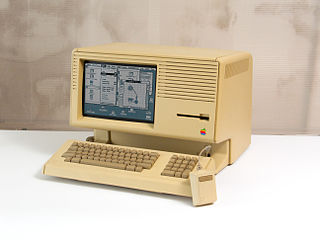 W
WThe Macintosh XL is a modified version of the Apple Lisa personal computer made by Apple Computer, Inc. In the Macintosh XL configuration, the computer shipped with MacWorks XL, a Lisa program that allowed 64 K Macintosh ROM emulation. An identical machine was previously sold as the Lisa 2/10 with the Lisa OS only.